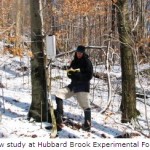
Redmond, Washington – Businesses that choose to run business applications in the cloud can help reduce energy consumption and carbon emissions by a net 30 percent or more versus running those same applications on their own infrastructure. These findings, from a study commissioned by Microsoft Corp. and conducted by Accenture and WSP Environment & Energy, demonstrate cloud computing’s potential to operate business applications more efficiently.
Large data-centers, like those run by Microsoft, benefit from economies of scale and operational efficiencies beyond what corporate IT departments can achieve. Benefits become even more significant for a small business moving to the cloud, where the net energy and carbon savings can be more than 90 percent.
The study results focused on three widely-deployed and commonly-used Microsoft applications for e-mail, content sharing and customer relationship management. Customers can choose to install each application on their own IT infrastructure or use the corresponding Microsoft cloud application. The study results suggest that choosing the cloud option can enable a significant reduction in carbon emissions. While the findings represent an illustrative case for selected Microsoft applications, it is likely that similar advantages can be observed across many applications and cloud service providers.
The study assessed the carbon footprint of server, networking and storage infrastructure for three different deployment sizes (100, 1,000 and 10,000 users), finding that the smaller the organization, the larger the benefit of switching to the cloud. When small organizations (100 users) move to the cloud, the effective carbon footprint reduction could be up to a 90 percent savings by using a shared cloud environment instead of their own local servers. For large corporations, the savings are typically 30 percent or more in energy consumption and carbon emissions using cloud applications. In a case study with a large consumer-goods company, the team calculated that 32 percent of emissions could be saved by moving 50,000 e-mail users in North America and Europe to Microsoft’s cloud.
Lower energy use and carbon emissions enabled by the cloud stem from a number of key factors:
- Dynamic Provisioning. Large operations enable better matching of server capacity to demand on an ongoing basis.
- Multi-tenancy. Large public cloud environments are able to serve millions of users at thousands of companies simultaneously on one massive shared infrastructure.
- Server Utilization. Cloud providers can drive efficiencies by increasing the portion of a server’s capacity that an application actively uses, thereby performing higher workloads with a smaller infrastructure footprint.
- Datacenter Efficiency. Through innovation and continuous improvement, cloud providers are leading the way in designing, building and operating datacenters that minimize energy use for a given amount of computing power.
The study determined that, although many organizations may be able to address some of these factors in their own datacenters to decrease energy use and emissions, due to economies of scale, providers of large, public cloud infrastructure are best positioned to help reduce the environmental impact of IT through efficiency and scale.
Beyond the commonly cited benefits of cloud computing – such as cost savings and increased agility – cloud computing has the potential to significantly reduce the energy use and carbon footprint associated with running business applications, according to the study. By moving applications to cloud services such as those offered by Microsoft, IT organizations can take advantage of highly efficient cloud infrastructure, thereby effectively “outsourcing” their IT efficiency investments and helping their companies achieve sustainability goals.
Click here to read the white paper detailing the study and its results.
About the Study
Using Life Cycle Assessment (LCA) methodology aligned to the Global e-Sustainability Initiative’s (GeSI) approach, the study compared the energy use and carbon emissions per user for Microsoft Exchange Server 2007, Microsoft SharePoint Server 2007 and Microsoft Dynamics CRM with their cloud-based equivalents: Microsoft Exchange Online, Microsoft SharePoint Online and Microsoft Dynamics CRM Online. Estimates of energy use and carbon footprint for the cloud applications are based on actual data from Microsoft’s cloud infrastructure. For applications running on Microsoft customers’ infrastructure, results can vary depending on each company’s selection of equipment, operational efficiency and usage patterns.
About Accenture
Accenture is a global management consulting, technology services and outsourcing company, with approximately 204,000 employees serving clients in more than 120 countries. Combining unparalleled experience, comprehensive capabilities across all industries and business functions, and extensive research on the world’s most successful companies, Accenture collaborates with clients to help them become high-performance businesses and governments. Accenture assists clients in developing and implementing sustainability strategies and solutions that not only protect the environment and enhance social wellbeing, but also serve as an engine for economic growth and high performance. The company generated net revenues of US $ 21.6 billion for the fiscal year ended August 31, 2010. For more information, visit www.accenture.com.
About WSP Environment & Energy
WSP Environment & Energy (E&E) is a global consultancy providing advice on all aspects of environmental, energy, sustainability, climate change, and business risk issues. WSP E&E is part of WSP Group, which provides management and consultancy services to the built and natural environment. For more information, visit www.wspenvironmental.com.
About Microsoft
Founded in 1975, Microsoft (Nasdaq “MSFT”) is the worldwide leader in software, services and solutions that help people and businesses realize their full potential. For more information, visit www.microsoft.com.
Source: Microsoft News Center Release dated November 4, 2010.













